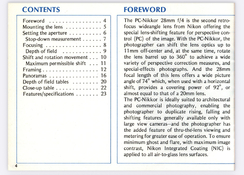Hi everyone,
I wasn’t quite sure where to post this, hopefully this is the right forum.
I’d like to share my latest video with you—a comprehensive, review of the Nikon PC-Nikkor 28mm f/3.5. Released in October 1980, it was at the time one of Nikon’s flagship—and most expensive—lenses.
Designed primarily for architectural photography, it is my conclusion (after extensive testing and real-world application) that the 28mm PC-Nikkor is unfit for that purpose, due to some fundamental optical shortcomings.
That being said, and despite its flaws, the lens renders images with a unique character that I’ve found deeply appealing, especially for documentary and street photography.
In fact, in many creative applications, I’d argue that perspective control / shift lenses like this—despite slower apertures and lack of autofocus—can surpass traditional primes in versatility, creativity and expressive potential.
This video is a follow-up to one I posted three years ago, but it goes much further in depth, both technically and practically.
It took some months to put this video together and I’d love to hear your thoughts.
Especially grateful for any constructive feedback on the presentation or information you would like to see included in future video lens reviews.
Thanks for watching,
Best wishes
Aleck
I wasn’t quite sure where to post this, hopefully this is the right forum.
I’d like to share my latest video with you—a comprehensive, review of the Nikon PC-Nikkor 28mm f/3.5. Released in October 1980, it was at the time one of Nikon’s flagship—and most expensive—lenses.
Designed primarily for architectural photography, it is my conclusion (after extensive testing and real-world application) that the 28mm PC-Nikkor is unfit for that purpose, due to some fundamental optical shortcomings.
That being said, and despite its flaws, the lens renders images with a unique character that I’ve found deeply appealing, especially for documentary and street photography.
In fact, in many creative applications, I’d argue that perspective control / shift lenses like this—despite slower apertures and lack of autofocus—can surpass traditional primes in versatility, creativity and expressive potential.
This video is a follow-up to one I posted three years ago, but it goes much further in depth, both technically and practically.
It took some months to put this video together and I’d love to hear your thoughts.
Especially grateful for any constructive feedback on the presentation or information you would like to see included in future video lens reviews.
Thanks for watching,
Best wishes
Aleck







